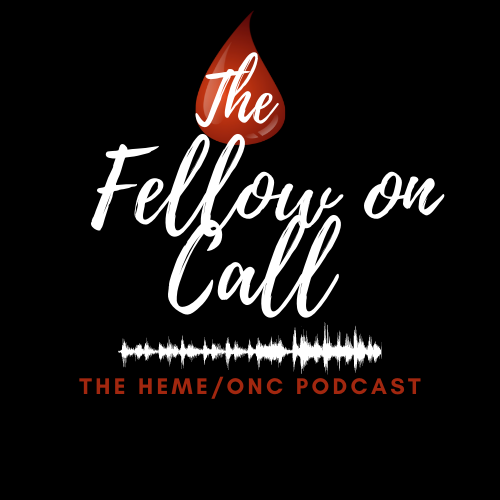Episode 123: AML Series, Pt 9 - Introduction to Allogeneic Transplant
In today’s episode, we welcome back Dr. Amar Kelkar for part 1 of our two-part discussion on allogeneic transplant. In this episode, we discuss the fundamental approach to patient selection and stem cell source selection. As you all know from this series, allogeneic transplants play a pivotal role in the management of AML. Dr. Kelkar’s pearls of wisdom help make this confusing topic so much more approachable!
What are the key factors for transplant eligibility in your mind?
Need to consider medical eligibility and then also factor in the other aspects that can impact care.
Medical eligibility: What risk group do they fall into?
For AML, this includes proceeding to transplant (or at least considering transplant) for patients with intermediate to high-risk disease, based on the ELN 2022 criteria
ELN 2022 Criteria. Source: Dohner et al. Blood. 2022. No copyright infringement intended.
Recall that we previously discussed a recent pooled analysis that incorporated the use of MRD status into transplant decision-making. Patients with MRD+ disease may benefit from transplant. This is evolving, however.
High risk secondary mutations may benefit from transplant
Overall health (fitness)
Comorbidities (HCT-TI score): 0-26 risk score that categorizes patients based on the risk score
Age: Many centers use age >75 as a hard cut off; others do not
Caregiver availability
Health literacy
Extremes of weight
Prior solid organ transplant
Social factors
Autoimmune diseases
How does HLA-matching come into play?
The most important HLA loci to be aware of:
HLA-A
HLA-B
HLA-C
HLA-DR
HLA- DQ
HLA-DP
These 6 loci (therefore 12 genes) are of critical importance; therefore in the present day, an optimal match is called “12/12”
HLA A, B, and C are found on all nucleated cells
Older BMT studies used HLA, B and C, therefore a perfect match was “6/6”
The addition of the other loci to our algorithm came in order to find greater compatibility/decrease the risk of GVHD, which lead to the discovery and addition of HLA DR, DQ and DP
These loci are found on all antigen presenting cells
HLA-DRB1 has the highest genetic variability, therefore increasing the risk of GVHD. Therefore studies started incorporating this, hence “8/8” becoming a perfect match when this was added into the mix.
Next, they added HLA-DQ, with HLA-DQB1 having the highest variability/most immunogenicity. When this was incorporated, we had “10/10” matches
Lastly, there was HLA-DP, with HLA-DPB1 having the highest variability, therefore leading to the “12/12” match
This information can then be put into a calculator though the NMDP website to find the best match
Of note, Europe still uses 8/8, incorporating HLA-A, B, C, and DR
When selecting a donor, why are sibling donors the most optimal? Why do cells from female donors lead to higher risk of GVHD?
Siblings have 25% chance of matching; given the fact that there are many more minor histocompatibility antigens, as well, a matched sibling donor is more likely to have these in common, therefore decreasing the risk of GVHD compared to an unrelated donor.
That being said, sometimes you would want to accept mismatch to induce a graft-versus-leukemia (GVL) effect.
Female donor stem cells, specifically from females who are multiparous, are associated with higher risk of cGVHD, therefore worsened survival
That being said, “The best donor is the available donor”
What are the pros and cons when comparing peripheral blood stem cell (PBSC) to bone marrow (BM) as a source of stem cells? What about cord blood?
Our understanding of PBSC vs. BM cells largely comes from a NEJM 2012 article
The authors found no real survival differences between the two sources of cells
However, for their secondary outcomes, they noted that with PBSC:
Higher CD34+ cell count
Faster engraftment
Can use growth factor to stimulate production
Better QOL for donor
Better GVL effect
Downside of PBSC: more cGVHD
We consider BM source when:
We have high concerns for GVHD, but less need for the GVL effect
For myeloid malignancies, most often you will see PBSC
For lymphoid malignancies, non-malignant transplants, and in young patients, more BM sources are used
Cord blood:
Cells are collected in the postpartum period
Not many centers do this anymore
Pros:
Rapid availability
Less matching required; we only need to match HLA A, B, and DR-B1 for matching cord blood
Cons:
Limited availability
Small doses available
Very expensive
Delayed time to engraftment, meaning higher infection risk, and thus higher transplant-related mortality
The BMT 1101 trial suggests that there was no difference in PFS, but there was an OS benefit to haploidental PBSC vs. cord blood
About our Guest:
Dr. Amar Kelkar, MD, FACP is a Stem Cell Transplantation Physician at the Dana-Farber Cancer Institute and an Instructor in Medicine at Harvard Medical School in Boston, MA. Dr. Kelkar attended medical school at St. George’s University School of Medicine, after which he completed residency at University of Illinois College of Medicine Peoria. He then went to University of Florida in Gainesville, Florida for his hematology/oncology fellowship and then to the Dana-Farber Cancer Institute for his bone marrow transplant fellowship.
The crew behind the magic:
Show outline: Ronak Mistry, Vivek Patel
Production and hosts: Ronak Mistry, Vivek Patel, Dan Hausrath
Editing: Resonate Recordings
Shownotes: Ronak Mistry
Social media management: Ronak Mistry
We are proud to partner with HemOnc.org!
Want to learn more about the trials that lead to the regimens discussed today? What about dosing schedules? See links in the show notes for a link to HemOnc.org
Have some extra time and want to make some extra money? Click here to get paid to participate in market research surveys!


